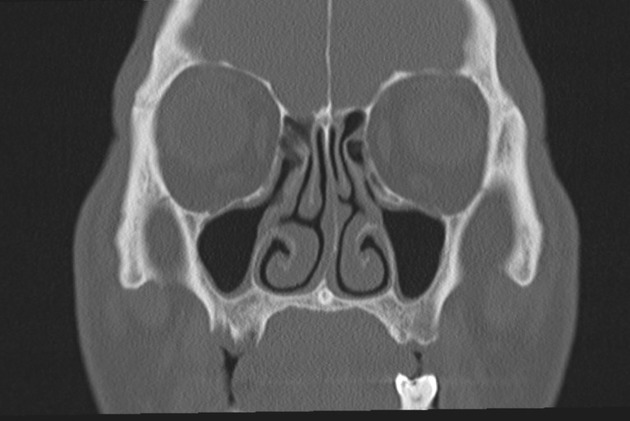The CT paranasal sinus protocol serves as an examination for the assessment of the study of the mucosa and bone system of the sinonasal cavities. It is usually performed as a non-contrast study.
NB: This article aims to frame a general concept of a CT protocol for the assessment of the paranasal sinuses. Protocol specifics will vary depending on CT scanner type, specific hardware and software, radiologist and perhaps referrer preference, and patient factors, e.g. implants, specific indications.
A typical CT of the paranasal sinus may be as follows:
On this page:
Images:
Indications
Typical indications include the following:
-
inflammatory disease
gas-fluid levels
mucosal disease
cysts and polyps
preoperative assessment including pre functional endoscopic sinus surgery (FESS)
Purpose
The purpose of a CT scan of the paranasal sinuses is to visualize the possible presence of inflammatory or newly formed tissue in the context of the paranasal cavities.
In neoplastic, inflammatory and infectious disorders, a CT scan of the paranasal sinuses is performed to demonstrate bony erosions, osteolytic lesions, and calcifications.
If neoplasia is suspected, the use of an intravenous contrast medium is indicated.
Technique
-
patient position
supine
-
scout
perpendicular to the hard palate
-
tube voltage and tube current
125 kV and 80–160 mAs
-
scan extent
from the hard palate to above the end of the frontal sinuses
-
scan direction
caudocranial
-
scan geometry
field of view (FOV): 140–160 mm
slice thickness: 0.625–1.0 mm
-
reconstruction kernel
bone kernel (e.g. ≥4000 HU), soft tissue kernel (e.g. 150 to 400 HU)
-
multiplanar reconstructions
coronal and sagittal images
Practical aspects
CT is beneficial in studying chronic disease of the paranasal sinuses, not least to assess whether it has spread to surrounding structures.
In addition, in the case of planned surgery, imaging can provide the surgeon with necessary information regarding any anatomical variants and allow the diagnosis of clinically silent diseases, e.g. the possible presence of brain aneurysms, tumors, etc.






 Unable to process the form. Check for errors and try again.
Unable to process the form. Check for errors and try again.